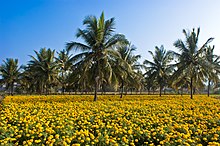Intercropping is a multiple cropping practice involving growing two or more crops in proximity. The most common goal of intercropping is to produce a greater yield on a given piece of land by making use of resources that would otherwise not be utilized by a single crop. Careful planning is required, taking into account the soil, climate, crops, and varietis. It is particularly important not to have crops competing with each other for physical space, nutrients, water, or sunlight. Examples of intercropping strategies are planting a deep-rooted crop with a shallow-rooted crop, or planting a tall crop with a shorter crop that requires partial shade. Inga alley cropping has been proposed as an alternative to the ecological destruction of slash-and-burn farming.
When crops are carefully selected, other agronomic benefits are also achieved. Lodging-prone plants, those that are prone to tip over in wind or heavy rain, may be given structural support by their companion crop. Creepers can also benefit from structural support. Some plants are used to suppress weeds or provide nutrients. Delicate or light-sensitive plants may be given shade or protection, or otherwise wasted space can be utilized. An example is the tropical multi-tier system where coconut occupies the upper tier, banana the middle tier, and pineapple, ginger, or leguminous fodder, medicinal or aromatic plants occupy the lowest tier.
Intercropping of compatible plants also encourages biodiversity, by providing a habitat for a variety of insects and soil organisms that would not be present in a single-crop environment. This in turn can help limit outbreaks of crop pests by increasing predator biodiversity. Additionally, reducing the homogeneity of the crop increases the barriers against biological dispersal of pest organisms through the crop.
The degree of spatial and temporal overlap in the two crops can vary somewhat, but both requirements must be met for a cropping system to be an intercrop. Numerous types of intercropping, all of which vary the temporal and spatial mixture to some degree, have been identified. These are some of the more significant types:
Chili pepper intercropped with coffee in Colombia's southwestern Cauca Department.
- Mixed intercropping, as the name implies, is the most basic form in which the component crops are totally mixed in the available space.
- Row cropping involves the component crops arranged in alternate rows. Variations include alley cropping, where crops are grown in between rows of trees, and strip cropping, where multiple rows, or a strip, of one crop are alternated with multiple rows of another crop. A new version of this is to intercrop rows of solar photovoltaic modules with agriculture crops. This practice is called agrivoltaics.
- Temporal intercropping uses the practice of sowing a fast-growing crop with a slow-growing crop, so that the fast-growing crop is harvested before the slow-growing crop starts to mature.
- Further temporal separation is found in relay cropping, where the second crop is sown during the growth, often near the onset of reproductive development or fruiting, of the first crop, so that the first crop is harvested to make room for the full development of the second.
- ^ Ouma, George; Jeruto, P (2010). "Sustainable horticultural crop production through intercropping: The case of fruits and vegetable crops: A review" (PDF). Agriculture and Biology Journal of North America 1 (5): 1098–1105.
- ^ Elkan, Daniel. Slash-and-burn farming has become a major threat to the world's rainforest The Guardian. 21 April 2004
- ^ Trenbath, B.R. 1976. Plant interactions in mixed cropping communities. pp. 129–169 in R.I. Papendick, A. Sanchez, G.B. Triplett (Eds.), Multiple Cropping. ASA Special Publication 27. American Society of Agronomy, Madison, WI.
- ^ Mt. Pleasant, Jane (2006). "The science behind the Three Sisters mound system: An agronomic assessment of an indigenous agricultural system in the northeast". In John E. Staller, Robert H. Tykot, and Bruce F. Benz. Histories of maize: Multidisciplinary approaches to the prehistory, linguistics, biogeography, domestication, and evolution of maize. Amsterdam. pp. 529–537.
- ^ Miguel Angel Altieri; Clara Ines Nicholls (2004). Biodiversity and Pest Management in Agroecosystems, Second Edition. Psychology Press.
- ^ Andrews, D.J., A.H. Kassam. 1976. The importance of multiple cropping in increasing world food supplies. pp. 1–10 in R.I. Papendick, A. Sanchez, G.B. Triplett (Eds.), Multiple Cropping. ASA Special Publication 27. American Society of Agronomy, Madison, WI.
- ^ Lithourgidis, A.S.; Dordas, C.A.; Damalas, C.A.; Vlachostergios, D.N. (2011). "Annual intercrops: an alternative pathway for sustainable agriculture" (PDF). Australian Journal of Crop Science 5 (4): 396–410.
- ^ Dinesh, Harshavardhan; Pearce, Joshua M. (2016-02-01). "The potential of agrivoltaic systems". Renewable and Sustainable Energy Reviews 54: 299–308. doi:10.1016/j.rser.2015.10.024.
- ^ Improving nutrition through home gardenin,, Home Garden Technology Leaflet 13: Multilayer cropping, FAO, 2001
- Intercropping at Washington State University
Wikipedia







No comments:
Post a Comment